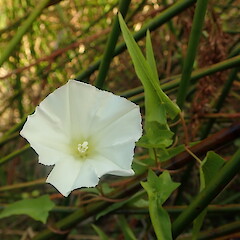Calystegia marginata
Common name
small-flowered white bindweed
Synonyms
None
Family
Convolvulaceae
Flora category
Vascular – Native
Endemic taxon
No
Endemic genus
No
Endemic family
No
Structural class
Lianes & Related Trailing Plants - Dicotyledons
NVS code
The National Vegetation Survey (NVS) Databank is a physical archive and electronic databank containing records of over 94,000 vegetation survey plots - including data from over 19,000 permanent plots. NVS maintains a standard set of species code abbreviations that correspond to standard scientific plant names from the Ngä Tipu o Aotearoa - New Zealand Plants database.
CALMAR
Chromosome number
2n = 22
Current conservation status
The conservation status of all known New Zealand vascular plant taxa at the rank of species and below were reassessed in 2017 using the New Zealand Threat Classification System (NZTCS) – more information about this can be found on the NZTCS website. This report includes a statistical summary and brief notes on changes since 2012 and replaces all previous NZTCS lists for vascular plants.
Please note, threat classifications are often suggested by authors when publications fall between NZTCS assessment periods – an interim threat classification status has not been assessed by the NZTCS panel.
- Conservation status of New Zealand indigenous vascular plants, 2017 . 2018. Peter J. de Lange, Jeremy R. Rolfe, John W. Barkla, Shannel P. Courtney, Paul D. Champion, Leon R. Perrie, Sarah M. Beadel, Kerry A. Ford, Ilse Breitwieser, Ines Schönberger, Rowan Hindmarsh-Walls, Peter B. Heenan and Kate Ladley. Department of Conservation. Source: NZTCS and licensed by DOC for reuse under the Creative Commons Attribution 4.0 International licence.
2017 | At Risk – Naturally Uncommon | Qualifiers: DP, SO, Sp
Previous conservation statuses
2012 | At Risk – Naturally Uncommon | Qualifiers: SO, Sp
2009 | At Risk – Naturally Uncommon | Qualifiers: SO, EF
2004 | Sparse
Distribution
Indigenous. North Island from Te Paki to Manukau in the West and Cuvier Island in the east. Also recorded on Rekohu (Chatham Island) in the Chatham Islands group. There are historic records from near Thames. Present in Eastern Australia.
Habitat
Primarily coastal but also found in lowland areas. Prefers open shrublands, rough pasture or bracken dominated sites, usually on coastal headlands, but also on road sides, along railway embankments and in rough pasture and lawns.
Detailed description
Glabrous perennial vine with creeping rhizome and slender twinning or prostrate stems (when prostrate these root freely at the nodes). Petioles slender (20-)50(-55) x 0.5-1 mm. Lamina bright green, 25-80 x 15-45 mm, sagittae, usually narrowly triangular (rarely broadly so); apex acute to acuminate; basal lobes acute, usually distinctly toothed (resembling a fish tail); basal sinus broad and rounded. Flowers usually solitary; peduncles 10-25 mm long, narrowly winged. Bracts broad-ovate, obtuse. 10 mm long. Sepals broad-ovate, < bracts, obtuse. Corolla 15 x 12 mm, white, campanulate. Capsule 6 mm diam., globose. Seeds black, reticulately ribbed, ribs protruberant.
Similar taxa
Can be confused with C. tuguriorum and vegetative forms of C. sepium subsp. roseata. From both it is readily distinguished by the bright-green, narrowly sagittate leaves with conspicuous fish tail-like notches on the basal lobes. The white flowers are much smaller than in either species and are borne on conspicuously winged peduncles. The seeds are covered in distinctive protuberances absent in the other two species.
Flowering
Present throughout the year but peaking in spring and summer
Flower colours
White
Fruiting
Present throughout the year
Life cycle
Capsules are water and possibly also wind dispersed (Thorsen et al., 2009).
Propagation technique
Easy from fresh seed. Somewhat weedy. The small arrow-shaped and tailed bright green leaves and tiny white flowers are quite unusual and attractive. Does well on an rock wall or on a grassy bank. Cold sensitive. An excellent coastal vine for a bach property.
Threats
Ignorance seems to be the main threat. Because it is frequently mistaken as a convolvulus, it is sprayed. Also its preference for successional habitats and along road margins tend to make it especially vulnerable to routine, roadside weed spraying. Despite this problem there is some field evidence to suggest it is actually increasing its range. Plants have even been found in urban areas such as Whangarei and Auckland, in situations where the species had not previously been known.
Etymology
calystegia: Name is derived from the Greek words kalyx ‘cup’, and stege ‘a covering’, meaning ‘a covered cup’, the calyx of some bindweeds being enclosed in two bracts.
marginata: From the Latin marginatus ‘edge, margin’, where one colour is surrounded by a very narrow rim of another
Attribution
Fact sheet prepared for NZPCN by P.J. de Lange 1 November 2005. Description adapted from Allan (1961) and Webb et al. (1988), supplemented with observations made from fresh and dried material.
References and further reading
Allan, H.H. 1961: Flora of New Zealand. Vol. I. Wellington, Government Printer.
Thorsen, M. J.; Dickinson, K. J. M.; Seddon, P. J. 2009. Seed dispersal systems in the New Zealand flora. Perspectives in Plant Ecology, Evolution and Systematics 11: 285-309
Webb, C.J.; Sykes, W.R.; Garnock-Jones, P.J. 1988: Flora of New Zealand. Vol. IV. Naturalised Pteridophytes, Gymnosperms, Dicotyledons.Christchurch, New Zealand, Botany Division, D.S.I.R..
NZPCN Fact Sheet citation
Please cite as: de Lange, P.J. (Year at time of access): Calystegia marginata Fact Sheet (content continuously updated). New Zealand Plant Conservation Network. https://www.nzpcn.org.nz/flora/species/calystegia-marginata/ (Date website was queried)








